
Catalog excerpts
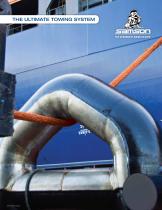
THE ULTIMATE TOWING SYSTEM Photo © Brian Gauvin
Open the catalog to page 1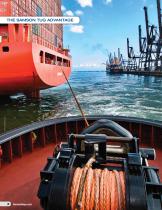
Photo © Brian Gauvin
Open the catalog to page 2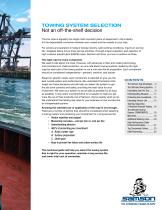
TOWING SYSTEM SELECTION The tow rope is arguably the single most important piece of equipment in the industry. It’s the dependable connection between your vessel and the vessels in your care. For owners and operators in today’s towing industry, safe working conditions, maximum service life, mitigated failure of tow lines are top priorities. Through proper evaluation and selection of high modulus polyethylene (HMPE) ropes, Samson will show you how to achieve all three. The right rope for every component. We used to talk about tow lines. However, with advances in fiber and coating technology...
Open the catalog to page 3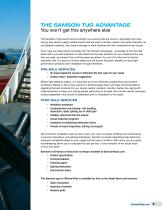
THE SAMSON TUG ADVANTAGE You won’t get this anywhere else The benefits of high-performance synthetic tug working lines are proven. Lightweight and ultrastrong, they reduce weight-related injuries and are easy to handle, inspect, and repair. Naturally cut and abrasion resistant, they reduce damage to deck hardware and the maintenance they require. Every rope we make comes complete with The Samson Advantage—a package of services that starts with a pre-sale evaluation to help determine the best products for your vessel and the way they are used, and doesn’t end until the ropes are retired. You...
Open the catalog to page 5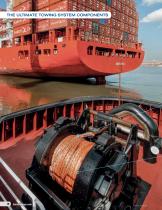
THE ULTIMATE TOWING SYSTEM COMPONENTS Photo © Brian Gauvin
Open the catalog to page 6
IT’S NOT JUST A ROPE, It’s a system With high bollard pull tugs becoming the norm for harbor tugs in ship assist and escort jobs, the tow line needs to evolve to take full advantage of the tug’s capabilities and capacities. Ropes made from high-performance fibers such as Dyneema® HMPE are lightweight, strong, and dependable, but that’s not all that’s required with today’s tugs and winches. Each component needs to be perfectly suited to its mission in order for the full system to provide greater efficiencies, easier handling, and longer service life. Samson’s towing system has been proven to...
Open the catalog to page 7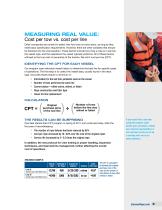
Measuring real value: Cost per tow vs. cost per line Other companies are content to select new tow lines on price alone, as long as they meet basic specification requirements. However, there are other variables that should be factored into the cost equation. These factors include how long a rope is in service, the vessel type, and the operations the vessel typically performs. All of these factors will lead to the true cost of ownership of the towline. We call it cost per tow (CPT). Identifying the cPT for each vessel Our program uses individual vessel history to determine the best line for...
Open the catalog to page 9
UNDERSTANDING ABRASION FIGURE A: Residual Strength of Tug Pendants THE PROOF IS IN THE NUMBERS RESIDUAL STRENGTH (% of New Rope MBS) Saturn-12 with Saturn Dynalene Average Residual strength based on testing 35 HMPE ropes from two manufacturers, after more than 27,000 combined pulls. 20.0% Saturn-12 with Saturn Dynalene 0.0% AmSteel ® -Blue Average AmSteel ® -Blue Other HMPE 12-Strand 1,000 1,200 1,400 1,600 TOTAL NUMBER OF JOBS Photo © Brian Gauvin
Open the catalog to page 10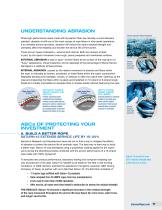
UNDERSTANDING ABRASION External abrasion without protection While high-performance ropes made with Dyneema® fiber are naturally cut and abrasion resistant, abrasion is still one of the main causes of rope failure in ship-assist operations. If no remedial actions are taken, abrasion will reduce the rope’s residual strength and ultimately affect the reliability and shorten the service life of the towline. There are two types of abrasion—external and internal. Both are caused, at least in part, by the rope’s movement over rough, poorly prepared and maintained surfaces. External abrasion is...
Open the catalog to page 11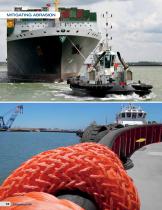
MITIGATING ABRASION
Open the catalog to page 12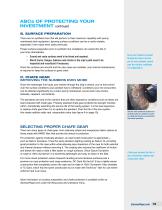
ABCs OF PROTECTING YOUR INVESTMENT continued B. SURFACE PREPARATION There are no synthetic lines that will perform to their maximum capability with poorly maintained deck equipment. Ignoring surface conditions can be a costly mistake, especially if wire ropes were used previously. Proper surface preparation prior to synthetic line installation can extend the life of your lines dramatically. > Scored and rusty surfaces need to be faired and repaired. > Winch drums, flanges, bullnose and chocks in the rope’s path need to be inspected and resurfaced if necessary. Once the surfaces are smooth...
Open the catalog to page 13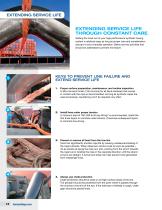
EXTENDING SERVICE LIFE EXTENDING SERVICE LIFE THROUGH CONSTANT CARE Getting the most out of your high-performance synthetic towing system is relatively easy as long as proper care and consideration are part of your everyday operation. Below are key activities that should be addressed to prevent line failure. Photo © Brian Gauvin KEYS TO PREVENT LINE FAILURE AND EXTEND SERVICE LIFE 1. Proper surface preparation, maintenance, and routine inspection A 300-microinch finish (7.62 microns) for all deck hardware that comes in contact with the rope is recommended. As long as synthetic ropes are...
Open the catalog to page 14
5. Inspect the ship’s chocks As you’re making the approach, look for the best surface conditions for the rope. If there’s a better option, it should be discussed with the pilot. It’s best to avoid roller chocks in general, and any chocks that are heavily scored from use with wire ropes. 6. Keep a proper working angle on the rope during the maneuver The angle of the rope measured from the horizontal determines the load on the rope. In general, a short scope on the rope causes a higher working angle on the rope and can dramatically increase the load on the rope. Whenever possible, use the...
Open the catalog to page 15
Inspection Guidelines and Residual Strength Testing Regular inspections and repair as needed will extend the working life of highperformance lines. Any rope that has been in use for a period of time will show normal wear and tear. Some characteristics of a used rope will not reduce strength while others will. Below we have defined normal conditions that should be inspected on a regular basis. The following criteria should be considered when inspecting 12-strand ropes made with Dyneema® fiber: Pulled Strand What > Visible sheen > Stiffness reduced by flexing the rope > Not to be confused...
Open the catalog to page 16All Samson catalogs and brochures
-
Offshore Sling Brochure
6 Pages
-
Vessel Mooring System
20 Pages
-
Chafe Gear Brochure
12 Pages
-
Saturn-12 Brochure
4 Pages
-
AGILE™ Lifting System
8 Pages
-
Recreational Marine Catalog
38 Pages
-
Tug Brochure
8 Pages
-
Mooring Brochure
4 Pages
-
AmSteel-Blue
2 Pages
-
Recreational Running Rigging
38 Pages
-
Commercial Marine
88 Pages















